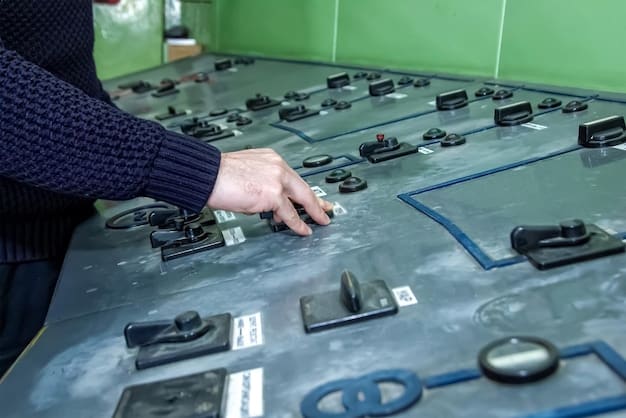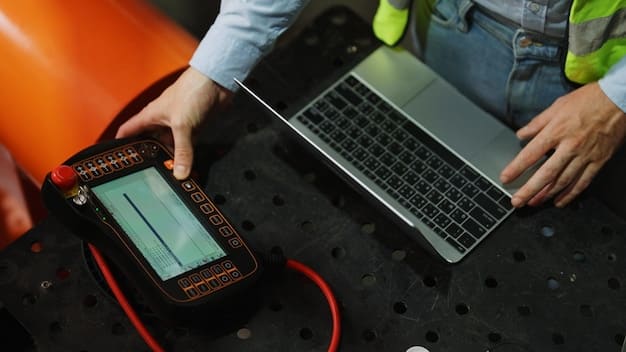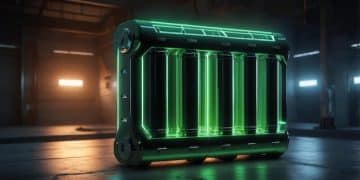How to Monitor & Maintain Your Energy Storage System in the US

Monitoring and maintaining your energy storage system in the US involves regular inspections, performance analysis, and proactive measures to ensure optimal efficiency, longevity, and safety, ultimately maximizing your investment and contributing to grid stability.
Ensuring your energy storage system operates at peak performance in the US requires a proactive approach. This guide covers essential strategies for monitoring and maintaining your system, maximizing its lifespan and efficiency.
Understanding the Importance of Monitoring Energy Storage Systems in the US
Energy storage systems are becoming increasingly crucial in the US for grid stability, renewable energy integration, and backup power. However, their performance can degrade over time if not properly monitored and maintained. Understanding why monitoring is essential is the first step toward ensuring your system’s longevity and efficiency.
Effective monitoring helps identify potential issues early, allowing for timely interventions and preventing costly repairs. It also provides valuable data for optimizing system performance and extending its lifespan.
Key Benefits of Regular Monitoring
Consistent monitoring of your energy storage system offers several key advantages.
- Early problem detection: Identifying anomalies and potential failures before they escalate into major issues.
- Performance optimization: Gaining insights into how the system is performing and making adjustments to maximize efficiency.
- Extended lifespan: Implementing preventative maintenance measures based on monitoring data.
- Safety assurance: Ensuring the system operates within safe parameters and preventing hazardous situations.
Furthermore, monitoring can assist in complying with warranty requirements and regulatory standards, providing a comprehensive view of the system’s operational health.
Investing in a robust monitoring system is not just about preventing downtime; it’s about maximizing the return on investment and ensuring the reliability of your energy storage asset.
Selecting the Right Monitoring System for Your Needs in the US
Choosing the appropriate monitoring system is crucial for effective maintenance. The ideal system depends on various factors, including the size, type, and application of your energy storage system. Consider the data points you need to track and the level of detail required to make informed decisions.
A well-chosen monitoring system provides real-time data on critical parameters, enabling proactive maintenance and performance optimization.

Factors to Consider When Choosing a Monitoring System
Selecting the right monitoring system involves evaluating several important factors.
- Data logging capabilities: The system should accurately record and store data for analysis and historical tracking.
- Remote access: The ability to monitor the system remotely via a web interface or mobile app is highly beneficial.
- Alerting and notification: The system should provide timely alerts for critical events, such as over-temperature or voltage anomalies.
- Compatibility: Ensure the monitoring system is compatible with your specific energy storage technology and communication protocols.
Also, consider the cost of the system, including installation, maintenance, and ongoing subscription fees. Evaluate the vendor’s reputation and customer support to ensure they can provide reliable assistance when needed.
Careful consideration of these factors will help you select a monitoring system that meets your specific requirements and provides the insights needed to maintain your energy storage system effectively.
Essential Parameters to Monitor for Peak Performance in the US
To maintain your energy storage system for peak performance, certain parameters must be consistently monitored. These parameters provide critical insights into the system’s health and performance, allowing for early detection of issues.
Tracking these metrics enables you to optimize system performance, extend its lifespan, and ensure safe operation.
Voltage: Monitoring voltage levels is crucial to ensure they remain within the specified operating range. Deviations can indicate cell imbalances, connection issues, or other problems. Consistent voltage monitoring helps prevent damage to the battery system and maintain optimal performance.
Temperature: Temperature is a critical factor affecting battery performance and lifespan. Elevated temperatures can accelerate degradation, while low temperatures can reduce capacity. Monitoring the temperature of individual cells or modules is essential to identify hotspots and ensure proper thermal management.
Current: Monitoring current levels is essential for assessing the charging and discharging behavior of the system. High current can lead to overheating and accelerated degradation, while low current may indicate issues with system efficiency. Tracking current helps optimize charging and discharging strategies for peak performance.
State of Charge (SOC): SOC indicates the amount of energy stored in the battery relative to its total capacity. Monitoring SOC is crucial for managing energy availability and preventing deep discharges, which can damage the cells. Accurate SOC monitoring allows for optimized energy usage and prolonged battery life.
State of Health (SOH): SOH is a measure of the battery’s overall condition compared to its original state. It reflects the cumulative effects of aging, cycling, and environmental factors. Monitoring SOH provides valuable insights into the remaining lifespan of the battery, allowing for proactive planning and replacement strategies.
By closely monitoring these parameters, you can gain a comprehensive understanding of your energy storage system’s health and performance, enabling timely interventions and maximizing its lifespan.

Implementing a Proactive Maintenance Schedule in the US
Regular maintenance is crucial for ensuring the continued performance and longevity of your energy storage system. A proactive maintenance schedule includes routine inspections, performance tests, and preventative measures to address potential issues before they escalate.
Implementing a structured maintenance plan helps maximize the lifespan of your system and prevent costly downtime.
Key Components of a Proactive Maintenance Schedule
A comprehensive maintenance schedule should include the following components:
- Visual Inspections: Regularly inspect the system for any signs of physical damage, corrosion, or leaks.
- Cleaning: Keep the system clean and free of dust and debris to ensure proper ventilation and thermal management.
- Connection Checks: Verify that all electrical connections are secure and free of corrosion.
- Performance Testing: Conduct regular performance tests to assess the system’s capacity, efficiency, and response time.
Also, consider implementing remote monitoring and diagnostic tools to identify potential issues early. Keep detailed records of all maintenance activities and performance data for future reference.
By adopting a proactive maintenance schedule, you can ensure your energy storage system operates at peak performance for years to come.
Troubleshooting Common Issues in US Energy Storage Systems
Despite proactive maintenance, issues can still arise in energy storage systems. Understanding common problems and how to troubleshoot them effectively is crucial for minimizing downtime and preventing further damage.
Knowing how to diagnose and resolve issues quickly can save time and money.
Common Issues and Troubleshooting Steps
Here are some common issues and troubleshooting steps for energy storage systems:
- Capacity Fade: Gradual reduction in the system’s energy storage capacity. This can be addressed by optimizing charging and discharging strategies, improving thermal management, or replacing degraded cells.
- Voltage Imbalance: Uneven voltage levels among cells or modules. This can be resolved by balancing the cells, replacing faulty modules, or adjusting the charging algorithm.
- Overheating: Excessive temperature build-up in the system. This can be mitigated by improving ventilation, optimizing cooling strategies, or reducing the load on the system.
- Communication Failures: Loss of communication between system components. This can be addressed by checking the wiring connections, updating firmware, or replacing faulty communication modules.
When troubleshooting, always follow safety protocols and refer to the manufacturer’s documentation for specific guidance. Consult with qualified technicians for complex issues that require specialized expertise.
By being prepared to troubleshoot common issues, you can minimize downtime and ensure the continued reliability of your energy storage system.
Ensuring Safety and Compliance in the US Energy Storage Sector
Safety and compliance are paramount in the energy storage sector. Operating an energy storage system safely requires adhering to industry standards, regulatory requirements, and best practices.
Prioritizing safety ensures the well-being of personnel and the protection of property.
Key Safety Considerations
Consider these safety elements:
- Electrical Safety: Follow proper lockout/tagout procedures and use appropriate personal protective equipment (PPE) when working on electrical systems.
- Thermal Management: Implement effective thermal management strategies to prevent overheating and thermal runaway.
- Fire Safety: Install fire suppression systems and train personnel on emergency response procedures.
- Ventilation: Ensure adequate ventilation to prevent the accumulation of explosive gases.
Also, comply with all applicable federal, state, and local regulations, including permitting requirements, safety codes, and environmental standards. Keep detailed records of all safety inspections, training sessions, and compliance activities.
By adhering to safety standards and compliance requirements, you can minimize risks and ensure the responsible operation of your energy storage system.
| Key Point | Brief Description |
|---|---|
| 🌡️ Temperature Monitoring | Track temperatures to prevent overheating and extend battery life. |
| 🔋 State of Health | Monitor SOH to assess overall battery condition and plan for replacements. |
| 🔌 Connection Checks | Regularly inspect connections for corrosion and secure fit. |
| 🚨 Alert Systems | Implement timely alerts for critical events like voltage anomalies. |
Frequently Asked Questions
▼
Monitoring helps identify potential issues early, optimize performance, extend lifespan, and ensure safe operation, ultimately maximizing the system’s return on investment.
▼
Essential parameters include voltage, temperature, current, state of charge (SOC), and state of health (SOH) to gain insights into system health and performance.
▼
Maintenance frequency depends on the system, but regular inspections, cleaning, connection checks, and performance testing are crucial for optimal operation.
▼
Common issues include capacity fade, voltage imbalance, and overheating. Troubleshoot by optimizing charging, improving thermal management, and replacing faulty components.
▼
Prioritize electrical safety, thermal management, fire safety, and ventilation. Comply with all regulations to ensure the responsible operation of the system.
Conclusion
Effectively monitoring and maintaining your energy storage system is crucial for ensuring its peak performance, safety, and longevity in the US. By implementing a proactive approach that includes regular inspections, data analysis, and adherence to safety standards, you can maximize your investment and contribute to a more reliable and sustainable energy future.





